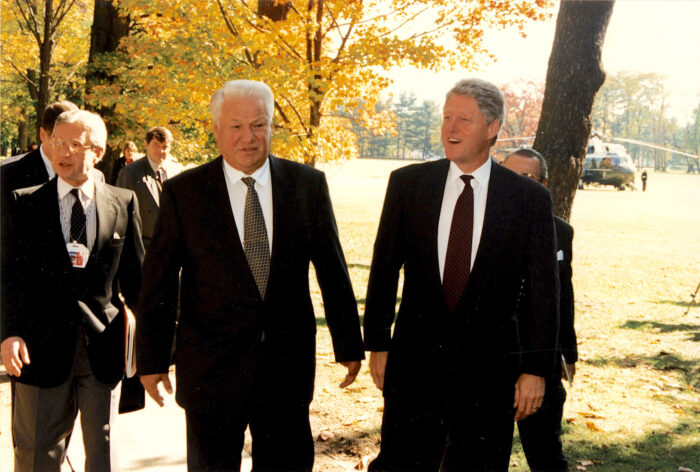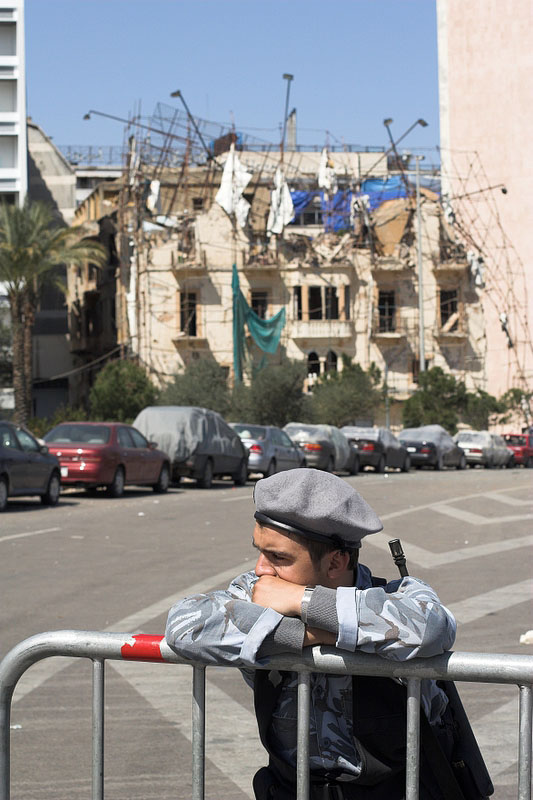The U.S. has declared “revolutions” on its own terms, and in its own image, writes As`ad AbuKhalil.

Protester in Baghdad carrying two tires and walking in front of a policeman on Jan. 13, 2020. (Kari0t, CC BY-SA 4.0, Wikimedia Commons)
By As`ad AbuKhalil
Special to Consortium News
 It is rather amusing to see Western media hailing, as of late, the advent of what they refer to as “Arab revolutions.” Western media never hail revolutions. Instead it propagandizes against revolutions in developing countries, as it did during much of the Cold War.
It is rather amusing to see Western media hailing, as of late, the advent of what they refer to as “Arab revolutions.” Western media never hail revolutions. Instead it propagandizes against revolutions in developing countries, as it did during much of the Cold War.
Why would anti-revolutionary Western media be suddenly interested in promoting what they now call “revolutions?” The answer is simple. These are not actual revolutions. Western governments and media want to bestow the title of “revolution” on political events and developments that serve its interests in order to give them political legitimacy and cachet.
When the U.S. government and Western media support what they call a “revolution,” you know it is not a revolution, and can’t be a revolution.
The U.S. has been unsettled since the end of the Cold War. After the Clinton administration (with the help of EU and Western lending institutions) secured the tenure of the corrupt Boris Yeltsin, the world was supposed to fall at its feet, now that the U.S. had become the sole global empire. Since that point, the U.S. has not stopped launching wars, under different names and with different goals.

Russian President Boris Yeltsin and President Bill Clinton meet at the home of FDR, 1995. (FDR Presidential Library and Museum via Flickr)
The U.S. was determined to impose world domination. No state, and no organization would stand in its way, and all means of control (from propaganda to the massive use of force) would be deployed. But why didn’t the world turn into a U.S. sphere? The U.S. government and its loyal media were frustrated.
The Arab world was a major irritant in the face of U.S. hegemony. Successive Arab public opinion surveys showed that despite years of wars and massive propaganda expenditure, the people of the region remain opposed to the U.S. and Israel.
Since the end of the Cold War, U.S. bombs have fallen on these Arab countries: Sudan, Libya, Somalia, Iraq, Yemen and Syria. And during that same period, Israel — the U.S. close ally — bombed the following Arab countries: Sudan, Egypt (through “anti-terrorism” campaigns in Sinai), Syria, Lebanon, Iraq; assassinated a Hamas leader in Dubai and had earlier attempted to assassinate the leader of Hamas in Amman, Jordan.
In the same period, the U.S. expanded its sponsorship of Arab despotic regimes. Because those regimes are the official sponsors of most Arab armies, the people living under those regimes became aware that their oppression had become both an external, as well as internal affair.
After Sept. 11, the Bush administration took the wars of the empire to another level: here was an opportunity to force the Arab world to submit to U.S. will, as if Bin Laden was the chosen leader of the Arab world. The invasion of Afghanistan was a mere prelude. Successive wars were supposed to change the political landscape of the Middle East, and make the region more hospitable to U.S. hegemony and Israeli occupation.
President George W. Bush dispatched his secretary of state, Colin Powell, to submit ultimata to all leaders of the region and Israel was given free rein to handle the Palestinians with more force.
The early phase of the Afghanistan war seemed promising, and that whetted the appetite of the Bush regime to invade more Arab countries, on the cheap. The Iraq invasion was supposed to lead to changes of regime in Syria and Iran. (Seven countries were supposed to be taken by the U.S. in total, according to Gen. Wesley Clark’s account.) No Middle East regime was supposed to block the projection of U.S. power.
What could be achieved by propaganda and covert action saved the metal and blood of the empire.

Ministry of the Interior soldier guarding the site of the attack that killed Hariri. (Petteri Sulonen, Flickr, CC BY 2.0, Wikimedia Commons)
The so-called Cedar Revolution in Lebanon in 2005 (which is a reference to protests by pro-Saudi regime crowds in the wake of the assassination of Rafiq Hariri) was an example of how the U.S. exploited the assassination of a corrupt right-wing billionaire for political ends. There was as much revolution in the political movement of March 14 (the right-wing coalition that the U.S. and Saudi embassies set up in Beirut) as in the Nicaraguan Contras.
But early U.S. success gave way to failures, defeats, stalemates, and various scandals related to human rights violations by U.S. armed forces (and their contractors) in Iraq and Afghanistan. The U.S. needed to reconsider its course of action.
The American public’s appetite for military victories and wars had substantially diminished. By the time Bush left office, the idea of another Middle East was seen as unthinkable. His successor, Barack Obama promised to end, not expand, Bush’s wars.
But the logic of the war empire would not have that. Obama managed to expand Bush’s wars and add new wars to the repertoire of empire. Large-scale invasions were by then out of the question, given the resilience and effectiveness of popular resistance to U.S. occupation in both Iraq and Afghanistan; the evidence of which is the attempts by the U.S. to “manage” its failed invasions in both countries and the constant deployment and redeployment. Meanwhile, popular antipathy to U.S. occupation, is not even acknowledged in U.S. political culture.
Under Obama, the U.S. was not going to “abandon” its imperial responsibilities. The new methods of war and intimidation were covert wars, drone attacks, assassinations, and the reliance on local armies and jihadist militants of Arab regimes to do the job — and to do the dying — on behalf of the U.S.
But then came the Arab Uprisings in 2011. The U.S. was initially taken aback since pro-U.S. depots were supposed to last forever. But when Zine el Abidine Ben Ali, the president of Tunisia, was ousted, and then Egypt’s Hosni Mubarak, a state of panic prevailed in D.C.

Protesters in Tahrir Square, Cairo, Egypt, in 2011 demanding end of Mubarak regime. (Jonathan Rashad, CC BY 2.0, Wikimedia Commons)
Counter-Revolutions
The U.S. then managed to organize the Arab counter-revolution. It aligned with Saudi Arabia and UAE (and Qatar in some places) to prevent real revolutions from occurring. The U.S. imposed three key principles on the parameters of acceptable change:
No. 1) that no constitutional ban on normalization with Israel be enacted and no closure of Israel embassies in places where they existed be allowed;
No. 2) that the military command would not be altered or changed in pro-U.S. regimes;
No. 3) that the governors of the Arab central banks would remain someone either approved or handpicked by the U.S. Treasury Department.
The Muslim Brotherhood were able to reach power in Tunisia, Libya, and Egypt after Rashid Ghannushi of Tunisia and a delegate of the Egyptian branch of the Brotherhood assured Zionists in the U.S. Congress and the Washington Institute for Near East Policy, or WINEP, that they would not push for confrontation with Israel or for a ban on normalization.
The U.S. was able to do business with regimes run by the Muslim Brotherhood provided that their foreign policy and militaries were handled by U.S.-picked generals in those countries. That was especially true in Egypt, where the U.S. pays an annual bribe to the military to impose the peace treaty with Israel on the Egyptian people. (Early in the uprising in 2011, Egyptian protesters set the Israeli embassy on fire, and were about to chase the Israeli “diplomats” inside, when the Egyptian army intervened at the request of the U.S. government).

Protest against U.S. wars in Iraq, Afghanistan, St. Paul, Minnesota, March 19, 2011. (Fibonacci Blue, Flickr)
The U.S. quickly realized that it could handle change, provided the change is managed carefully with the use of client armed forces.
In Tunisia, the U.S. looked the other way when the UAE regime arranged for the coup by General Rashid Ghannushi in 2014, and when the UAE also tried to overthrow the pro-Qatar government in Libya.
The U.S. declared “revolutions” on its own terms, and in its own image. Using the Western tentacles of NGOs, the U.S. spread the themes of local issues and peaceful change (only for clients of the U.S., as violence is permitted against U.S. foes) while banning any support for resistance groups in the region.
Under U.S. orders, all pro-Arab regimes banned funding for the Palestinians and also any declaration of support for resistance to Israeli occupation and aggression. If those bans took the shape of sectarian anti-Shiite rhetoric, the U.S. didn’t mind as long as governments (like UAE and Saudi Arabia) were switching from anti-Semitism to hostility to Shiites and Alawites. In Syria, the U.S. actually derailed an Arab uprising and allowed Gulf regimes to arm an insurrection which wound up helping the regime in its quest for political survival.
In recent months, Iraq and Lebanon have witnessed what some local protesters call (comically or tragically) “revolutions.”
In Iraq, the protests started with the sacking of a client general of the U.S., Gen. Abdul Wahab Asaadi, (who was trained by the U.S. in counter-terrorism). Western media quickly took the cause of the Iraq protesters because they had an anti-Iran cast. When some protesters set the Iranian consulate on fire in Najaf, the event was hailed by Western media. (Compare the coverage of the burning of the Iran consulate with that of the attempt to storm into the U.S. embassy in Iraq).
Images of a few hundred (or sometimes dozens) of protesters who chanted against Iran were more prominently published and circulated than images of hundreds of thousands of Iraqis (or Iranians for that matter) who protested against the U.S.
October 27 – Baghdad, #Iraq
Hundreds of Iraqi protesters remained in Baghdad's Tahrir Square in the face of the recent bloody crackdown that left dozens killed, according to Reuters.pic.twitter.com/7DDrBFJKDf— People's Mojahedin Organization of Iran (PMOI/MEK) (@Mojahedineng) October 27, 2019
Western media here operate as a mere arm of the U.S. government apparatus. But what is revolutionary about those protests? In Lebanon, there is a genuine popular uprising going on but it has thus far failed to dislodge the corrupt sectarian regime. The bulk of the ruling class there are clients of the U.S. and Saudi regime.
The U.S. has turned what started as genuine popular uprisings against despots into opportunities for political exploitation in favor of the regional regime order and against the enemies of Israel. The pain of the Lebanese and Iraqi people is largely the doing of the U.S. government. The U.S. has few qualms about inflicting more pain and harm on the people of the region if serves the interests of its hegemony or the Israeli occupation project.
As’ad AbuKhalil is a Lebanese-American professor of political science at California State University, Stanislaus. He is the author of the “Historical Dictionary of Lebanon” (1998), “Bin Laden, Islam and America’s New War on Terrorism (2002), and “The Battle for Saudi Arabia” (2004). He tweets as @asadabukhalil
The views expressed are solely those of the author and may or may not reflect those of Consortium News.
If you value this original article, please consider making a donation to Consortium News so we can bring you more stories like this one.
Before commenting please read Robert Parry’s Comment Policy. Allegations unsupported by facts, gross or misleading factual errors and ad hominem attacks, and abusive or rude language toward other commenters or our writers will not be published. If your comment does not immediately appear, please be patient as it is manually reviewed. For security reasons, please refrain from inserting links in your comments, which should not be longer than 300 words.

“When the U.S. government and Western media support what they call a “revolution,” you know it is not a revolution, and can’t be a revolution.”
It is a revolution revolving around a constrained point in the hope of returning to the same point whether the motion appears to be going backward or forward.
A spectacle of sham like “representative democracy”.
“The Sham of Arab Revolutions”
Focus is a process of limitation not only leading to “Sam” being regularly run over as in the Roadrunner cartoon.
“The U.S. was determined to impose world domination. No state, and no organization would stand in its way, and all means of control (from propaganda to the massive use of force) would be deployed. But why didn’t the world turn into a U.S. sphere? The U.S. government and its loyal media were frustrated. “
Even when conducted by the opponents, analysis of what is “The United States of America” and how it is facilitated outlines the necessity of sham in delaying frustration and facilitating continuance of “The United States of America”.
Sham is facilitated by the target audiences’ notions of plausible belief and delivered in varying guises – the little girl who would sit down and eat worms routine, sometimes know as the Samson option and the boy who cried wolf routine on mantra of “indispensable nation” and “We the people hold these truths to be self-evident”.
The spectra of plausible belief have been enhanced by the opponents’ attempts at undermining facility in analytical methods reliant on testing hypotheses to increase reliance on fiat, encouraging others experiencing the opponents’ attempts to develop and implement analytical methods reliant on testing hypotheses – the blowback of sham sometimes implemented in the opponents’ cloak of sham within the opponents’ frame of plausible belief, including but not limited to “We won the Cold Warness” – re-iterating the frustration of “The United States of America” – a regime of social relations not restricted to “The US government and its loyal media”.
No mention of the Israeli YINON PLAN which subsequently became the BIDEN PLAN (Uncle Joe) which called for US attacks on the same Arab and African countries which the US invaded or bombed or otherwise subverted. The plan was to break up neighboring countries which could oppose Israeli domination of the region. Iraq, the main target after Iran, was to be divided into three parts, Sunni, Shia and Kurd. Syria was to undergo regime change, the leadership to be replaced with a “friendly” leader who would not object to the transfer of the Golan Heights, and Lebanon south of the Litani River, to Israeli control and ownership. The Russians have so-far delayed their plan.
Well, thanks for all the gloomy news and forecasts, As’ad!!! Is there any hope for the future? Possible new POTUS and team in the USA starting next year does not seem to provide much likelihood for optimism.